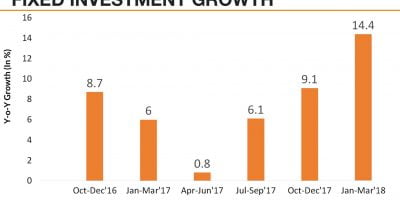Commodity-driven economies and commodity market indices all point to weakness in commodity prices. Your investment portfolios should reflect this weakness.
Commodity markets have not recovered to the peaks seen in 2007-08. The benchmark commodity index the Reuters CRB Index that tracks a basket of 19 commodities is down close to 40 percent from the peaks seen in 2007. Commodity-weighted equity indices such as the Brazilian Index and the Russian Index are down 15 percent and 37 percent from the highs seen in 2007.

Representational image.
Getty Images
China the world’s largest consumer of commodities has seen its equity indices down 62% from the highs seen in 2007. China’s GDP growth slowdown from double-digit levels to around 7.5% to 8% levels is reflecting on commodity markets globally.
Over one year period, the Reuters CRB index is down around 4% while equity indices of Brazil, Russia and China are down 19%, 11% and 13%, respectively. The Australian dollar that was a symbol of strength until 2012 has lost 15 percent over the last one year as commodity price weakness has pushed its economy down with budget running at deficits.
Gold, the safe haven for inflation was down 28 percent over the last one year. Commodity markets are clearly factoring a long period of deflationary conditions with CPI (consumer price index) in the US and Eurozone reflecting lack of inflation. Central bankers are more worried about deflation with the IMF president calling for decisive action against deflation even as the World Bank raised economic growth forecasts for the year 2014.
Indian equities have outperformed its commodity-driven peers with positive movements since peaks seen in 2007-08 and with around 5% one-year returns. The rupee has gone the way of the its emerging market peers with a drop of 57% from the highs seen in 2007-08 and a drop of 12% over the last one year. The rupee fell on the back of high fiscal and current account deficits that led to rising inflation, high interest rates and falling economic growth.
However the rupee’s fall has been largely positive for India’s export sector with the BSE IT and Healthcare indices recording smart gains of 145% and 260% over the last five years. The fact that despite weak macro and weak rupee, the Sensex and Nifty have managed to stay positive in the face of weakness among its BRIC peers indicate the depth of the Indian markets where well run private sector companies are able to keep their heads high despite headwinds.
Going forward, commodities such as oil are likely to see weakness in prices as US turns net exporter while countries such as UK embrace fracking for extraction of shale oil and gas. Trend economic growth is well below levels seen in the 2000-2010 decade for the BRIC countries and other emerging economies and this would keep down demand for commodities globally.
Commodities could look up when global economic growth picks up on a sustained basis and when inflation starts to look up in the developed economies. However, as of now that does not seem to be the case and commodities as an asset class will be underperformers.
[Source:- firstpost]


